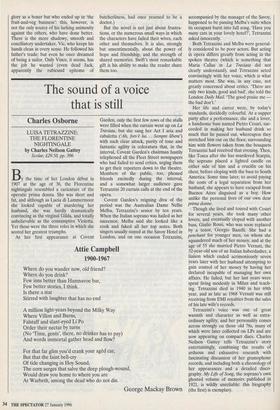The sound of a voice that is still
Charles Osborne
LUISA TETRAZZINE: THE FLORENTINE NIGHTINGALE by Charles Neilson Gattey Scolar, f29.50, pp. 396 By the time of her London debut in 1907 at the age of 36, the Florentine nightingale resembled a caricature of the operatic prima donna. She was short and fat, and although as Lucia di Lammermoor she looked capable of murdering her husband, she was hardly dramatically convincing as the virginal Gilda, and totally unbelievable as the consumptive Violetta. Yet these were the three roles in which she scored her greatest triumphs.
At her first appearance at Covent Garden, only the first few rows of the stalls were filled when the curtain went up on La Traviata, but she sang her Act I aria and cabaletta (`h, foree lui. . . Sempre libera') with such clear attack, purity of tone and fantastic agility in coloratura that, in the interval, Covent Garden's chairman hastily telephoned all the Fleet Street newspapers who had failed to send critics, urging them to get their reporters down to the theatre. Members of the public, too, phoned friends excitedly during the interval, and a somewhat larger audience gave Tetrazzini 20 curtain calls at the end of the opera.
Covent Garden's reigning diva of the period was the Australian Dame Nellie Melba, Tetrazzini's senior by ten years. When the Italian soprano was hailed as her successor, Melba said she looked like a cook and faked all her top notes. Both singers usually stayed at the Savoy Hotel in London, and on one occasion Tetrazzini, accompanied by the manager of the Savoy, happened to be passing Melba's suite when its occupant burst into full song. 'Have you many cats in your lovely hotel?', Tetrazzini asked innocently.
Both Tetrazzini and Melba were general- ly considered to be poor actors. But acting in opera differs greatly from acting in the spoken theatre (which is something that Maria Callas in La Traviata did not clearly understand), and Tetrazzini acted convincingly with her voice, which is what matters most. She was, in any case, not greatly concerned about critics. 'There are only two kinds, good and bad', she told the London Daily Mail. 'The good praise me the bad don't.'
Her life and career were, by today's standards, decidedly colourful. At a supper party after a performance, she and a lover, a handsome bass named Pietro Cesari, suc- ceeded in making her husband drink so much that he passed out, whereupon they stretched him out on the floor, surrounding him with flowers taken from the bouquets Tetrazzini had received that evening. Then, like Tosca after she has murdered Scarpia, the soprano placed a lighted candle on either side of him and a crucifix on his chest, before eloping with the bass to South America. Some time later, to avoid paying the costs of a legal separation from her husband, she appears to have escaped from Buenos Aires disguised as a boy. How unlike the personal lives of our own dear prima donne.
Though she lived and toured with Cesari for several years, she took many other lovers, and eventually eloped with another bass, Giulio Rossi, who was soon replaced by a tenor, Giorgio Bazelli. She had a penchant for younger men, on whom she squandered much of her money, and at the age of 55 she married Pietro Vernati, the 32-year-old son of an Italian haberdasher, a liaison which ended acrimoniously seven years later with her husband attempting to gain control of her money by having her declared incapable of managing her own affairs. He failed, but her last years were spent living modestly in Milan and teach-- ing. Tetrazzini died in 1940 in her 69th year, and as late as 1968 Vernati was still receiving from EMI royalties from the sales of his late wife's records.
Tetrazzini's voice was one of great warmth and character as well as extra- ordinary agility, and her personality comes across strongly on those old 78s, many of which were later collected on LPs and are now appearing on compact discs. Charles Neilson Gattey tells Tetrazzini's story entertainingly, combining the results of arduous and exhaustive research with fascinating discussion of her gramophone records, and including both a chronology of her appearances and a detailed disco- graphy. My Life of Song, the soprano's own ghosted volume of memoirs published in 1921, is wildly unreliable: this biography (the first) is exemplary.


























































 Previous page
Previous page